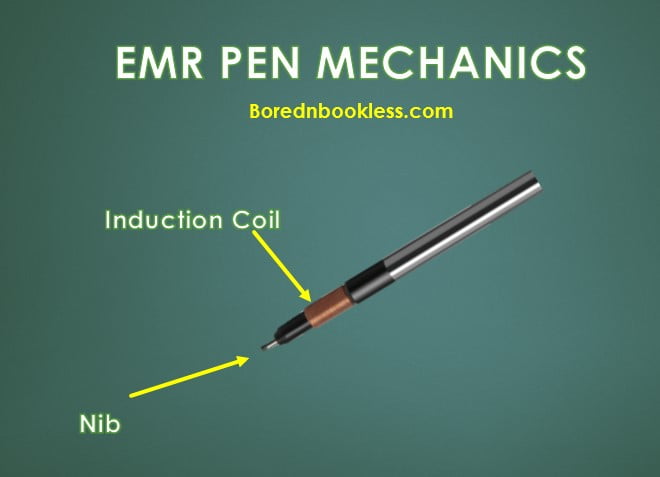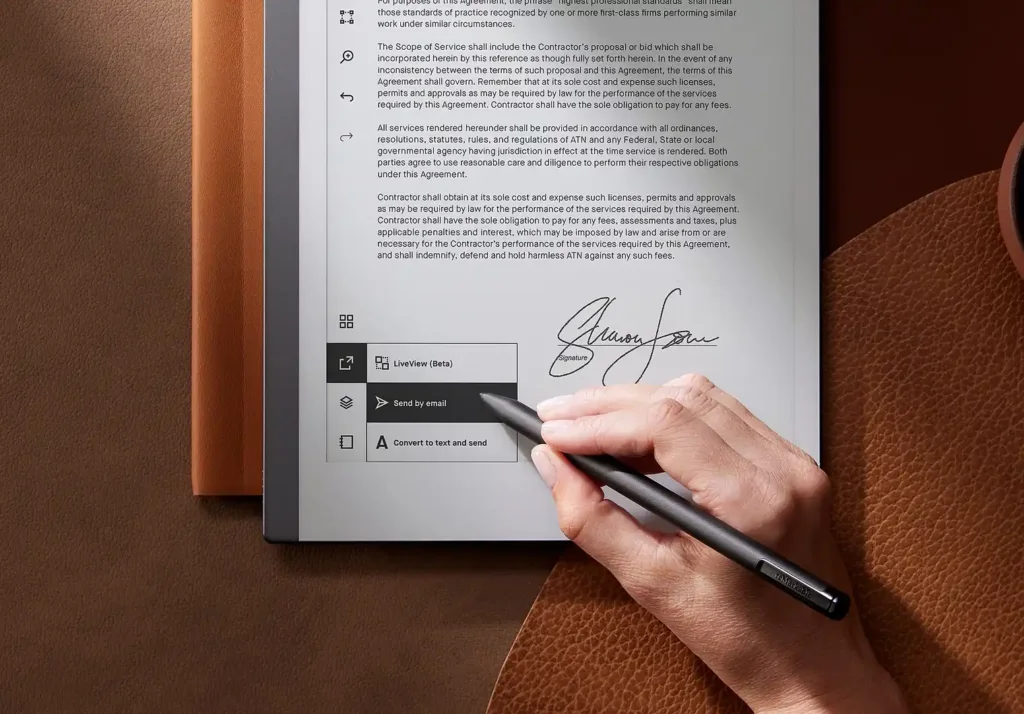EMR technology, short for Electromagnetic Resonance, is the driving force behind modern graphics tablets. In this article, we’ll delve into the inner workings of EMR technology, exploring how it powers graphics tablets, detects pen position, tilt, pressure, and even button presses.
What Is an EMR Pen
EMR Pens are digital pens based on cutting-edge near-field technology renowned for its pinpoint precision in stylus inputs. This sophisticated technology harnesses a combination of sensors, intricate control algorithms, and swift data transmissions to deliver an on-screen handwriting experience that rivals the tactile feel of pen and paper.
Originally conceived and developed by Wacom, EMR technology has revolutionized the digital stylus landscape. Its core mechanism relies on the principles of electromagnetic induction to establish seamless communication between a tablet and an electromagnetic pen.
Although Wacom initially held exclusive patents for EMR technology, it has since been embraced by other prominent manufacturers, including Huion and XP Pen, further expanding its reach and influence in the realm of digital input devices.
EMR Mechanism
EMR technology relies on the interaction between a grid of wires positioned behind the device’s screen and a pen equipped with a magnetic coil. This grid of wires resonates at a specific frequency, creating a magnetic field that extends about 5mm beyond the screen while the pen’s magnetic coil can modify this frequency slightly depending on its actions.
When the pen approaches the screen, the coil behind the screen detects the modified signal in particular wires, allowing for precise positioning of the pen on the screen.
Additionally, EMR pens can alter the properties of their resonating signal based on various actions. Different frequencies may be used for pen touch, side button activation, or eraser usage.
One of the key features of EMR technology is its ability to wirelessly power the electromagnetic pen. This is achieved through a process that involves two separate circuits – one in the tablet and one in the pen.
The tablet generates an alternating current (AC) that flows through an inductor coil. This changing current induces a current in the coil of the pen, effectively delivering power without the need for wires or batteries.

Use of Inductor-Capacitor circuit
Inductors, simple electronic components, play a crucial role in this process. Inductors are coils of wire that store energy in a magnetic field. The amount of energy an inductor can store is determined by its inductance, which can be adjusted by changing factors like the number of coils or the size of the coils. In essence, inductors act as temporary batteries in the EMR system.
Inductor-Capacitor circuit, is at the heart of EMR technology. In this circuit, the inductor in the tablet and the coil in the pen work in tandem. When the tablet powers the pen momentarily, the inductor in the pen stores energy in its magnetic field, leading to resonance.
The resonant frequency is a key factor in EMR technology, and slight modifications in inductance or capacitance can result in different resonant frequencies.
Detecting Pen Position
EMR technology is not just about wireless power delivery. It’s also highly adept at pinpointing the pen’s position on the tablet.
To pinpoint the exact position of the pen on a surface, EMR technology interpolates the data received from multiple grid lines.
For instance, if a grid consists of three horizontal and three vertical lines, and the top-left and leftmost lines receive the strongest signals, the device deduces that the pen is located at the top-left corner. The actual position, however, is determined with greater precision by considering the weighted data from several grid lines.
By employing a grid of coils both horizontally and vertically, the tablet can triangulate the pen’s location accurately. When the pen is in close proximity, the coils interact with its magnetic field, allowing for precise positioning.
Pen Tilt Detection in EMR
EMR technology is also capable of detecting the tilt of the pen. Tilt information is derived by assessing the geometry of the EMR signal across multiple grid lines.
When the pen is held upright, the signal geometry appears round, but when it is tilted, the geometry transforms into an ellipse, allowing the device to detect and interpret the tilt angle.
This capability enables artists to achieve varying line thicknesses and shading effects in their digital artwork.
Pen Pressure In EMR
EMR technology goes a step further by conveying pressure data through variations in the shape of the transmitted pulse.
Pen pressure sensitivity is a crucial feature for digital artists. EMR pens achieve this by incorporating a plastic nib that presses against a sensor rod within the pen.
When the nib exerts pressure on the rod, it changes the inductance in the pen’s coil, altering its resonant frequency. The tablet can interpret these changes to produce varying line thicknesses, mimicking the feel of traditional drawing.
This is why we see an incorrectly attached nib can cause the Pen to write without even touching the screen.
Detecting Pen Buttons
EMR pens often feature buttons that enhance their functionality. These buttons can be implemented using frequency modulation, amplitude modulation, or phase modulation of the electromagnetic signal.
By altering these parameters, the tablet can recognize button presses and respond accordingly, adding versatility to the pen’s capabilities.
Are EMR & AES The Same?
When it comes to digital stylus technologies, EMR (ElectroMagnetic Resonance) and AES (Active ElectroStatic) stand out as two distinct approaches. Each of these technologies has its own unique characteristics and limitations, making them incompatible with one another.
AES Technology: AES, or Active Electrostatic Sensing, is another technology employed in digital pens. In AES, the interaction takes place between an array of charged points and a conductive object, such as a human finger or an AES pen. Unlike EMR’s grid of antennas, AES uses a collection of individual charged points as sensors.
EMR vs. AES
One of the primary distinctions between EMR and AES stylus technologies lies in their power sources. EMR stylus pens draw their power from a built-in electromagnetic sensor located behind the screen of the tablet or device they are designed for.
On the other hand, AES stylus pens are powered by batteries contained within the stylus itself. This power source dissimilarity is a crucial factor that contributes to their incompatibility.
Position Detection in AES
In AES technology, position detection is achieved by analyzing the strength of the signals received at each individual sensor point. The position of the pen is interpolated based on the signal strength at these points, allowing for accurate tracking of the pen’s movement across the surface.
Tilt and Pressure Sensing in AES
AES technology also excels in detecting tilt and pressure. When it comes to detecting tilt, the distance between the signal received from the pen’s down-emitter and the signal from its side-emitters is measured. This information provides insights into the angle at which the pen is held. Additionally, AES technology is capable of conveying pressure information along with the signal, making it versatile for various applications.
Can You Use a Stylus with a Non EMR Screen?
No you cannot use EMR Styluses on Non EMR Screens. Furthermore, It’s essential to understand that no software or code can magically make a stylus of one technology type work on a device designed for another.
For instance, if a device incorporates Wacom technology, it cannot function with an AES stylus, and vice versa. The technology underpinning each stylus type is inherently different, making cross-compatibility impossible without the required hardware support.
Apple Pencil’s: The Apple Pencil, a prominent example of AES technology, utilizes a tip-pointing emitter and two side-pointing emitters. These emitters interact with a capacitive-touch array on Apple devices.
Samsung S Pens: Many Samsung devices, including the Note phone series and Tab S line support EMR pens. These pens are often interchangeable among these devices, providing users with flexibility in their stylus choices. So they can be used with other E Ink devices like E Ink Tablet but not with an iPad.
In summary, both EMR and AES technologies offer unique solutions for digital pen input, with EMR relying on electromagnetic resonance and AES utilizing capacitive electrostatic sensing. Each technology has its strengths, and their implementation, as seen in products like the Apple Pencil, continues to shape the world of digital creativity and productivity.
Benefits of EMR
Stylus is battery-free and inexpensive: requires no batteries, cables or charging. This means there are no batteries to wear out, or power cables to twist and break.
Touch panel and stylus work through different sensors: they can either be combined or excluded. So, the touch will never interfere with the stylus.
Liked This? Find out more..
Check Out Best EMR Pens
Check Out Best Styluses for reMarkable, Supernote, Onyx Boox & Kindle



